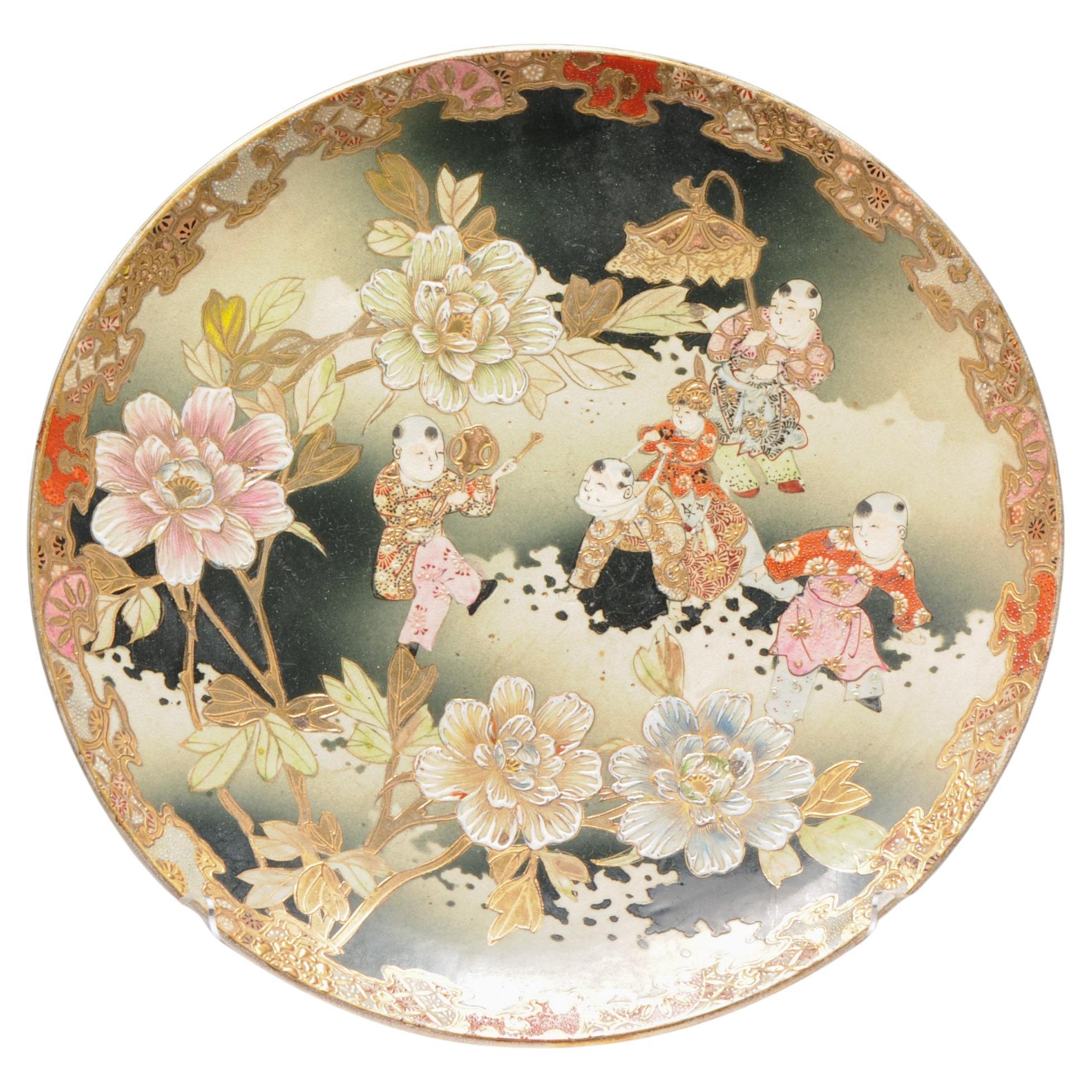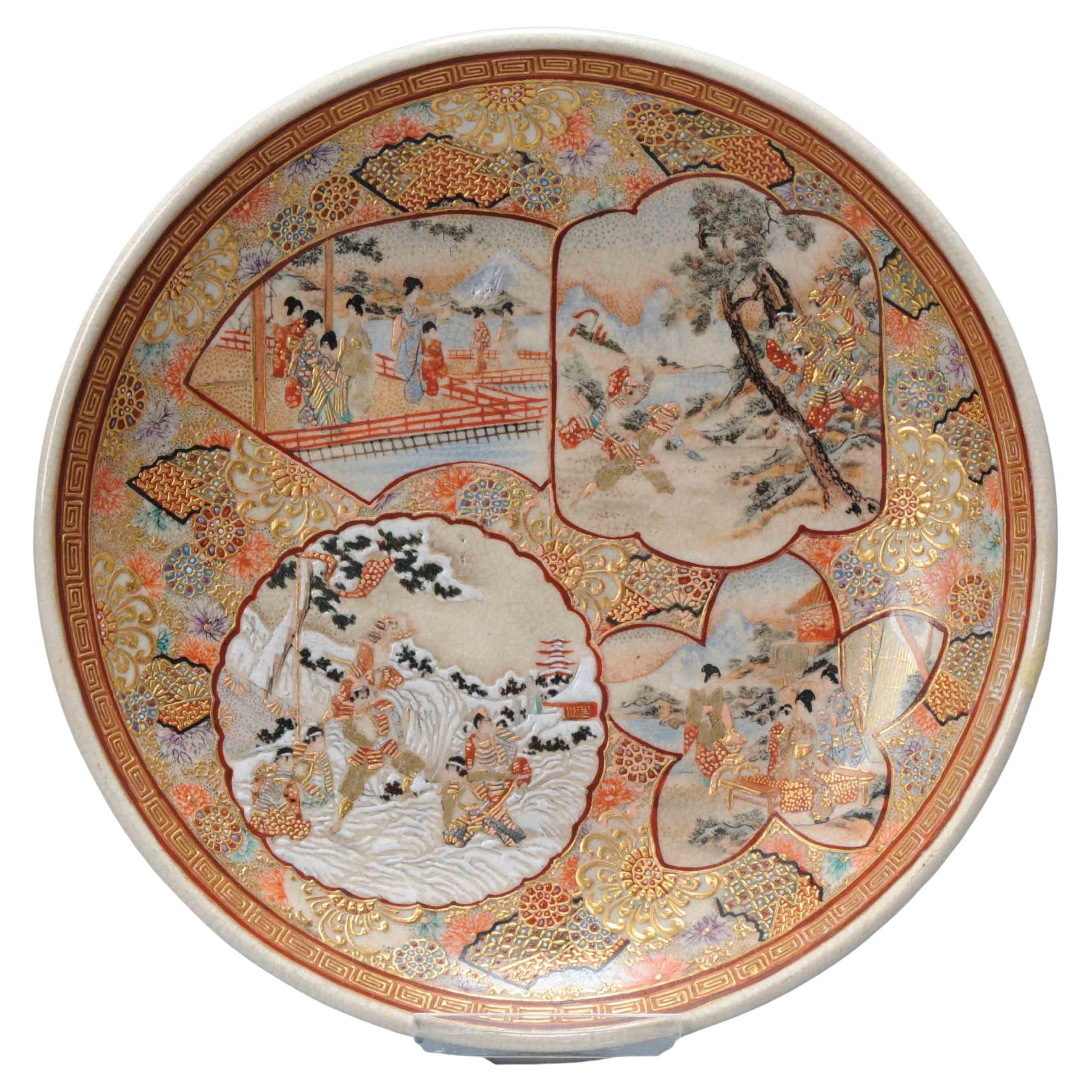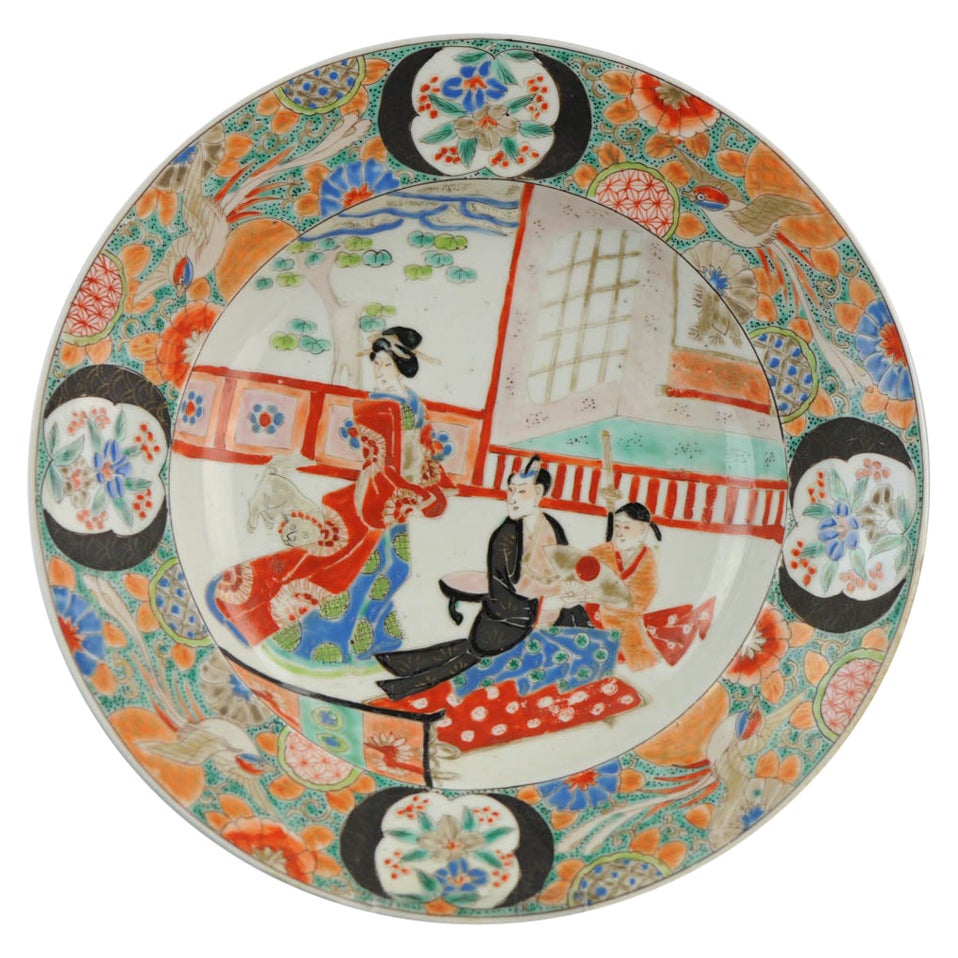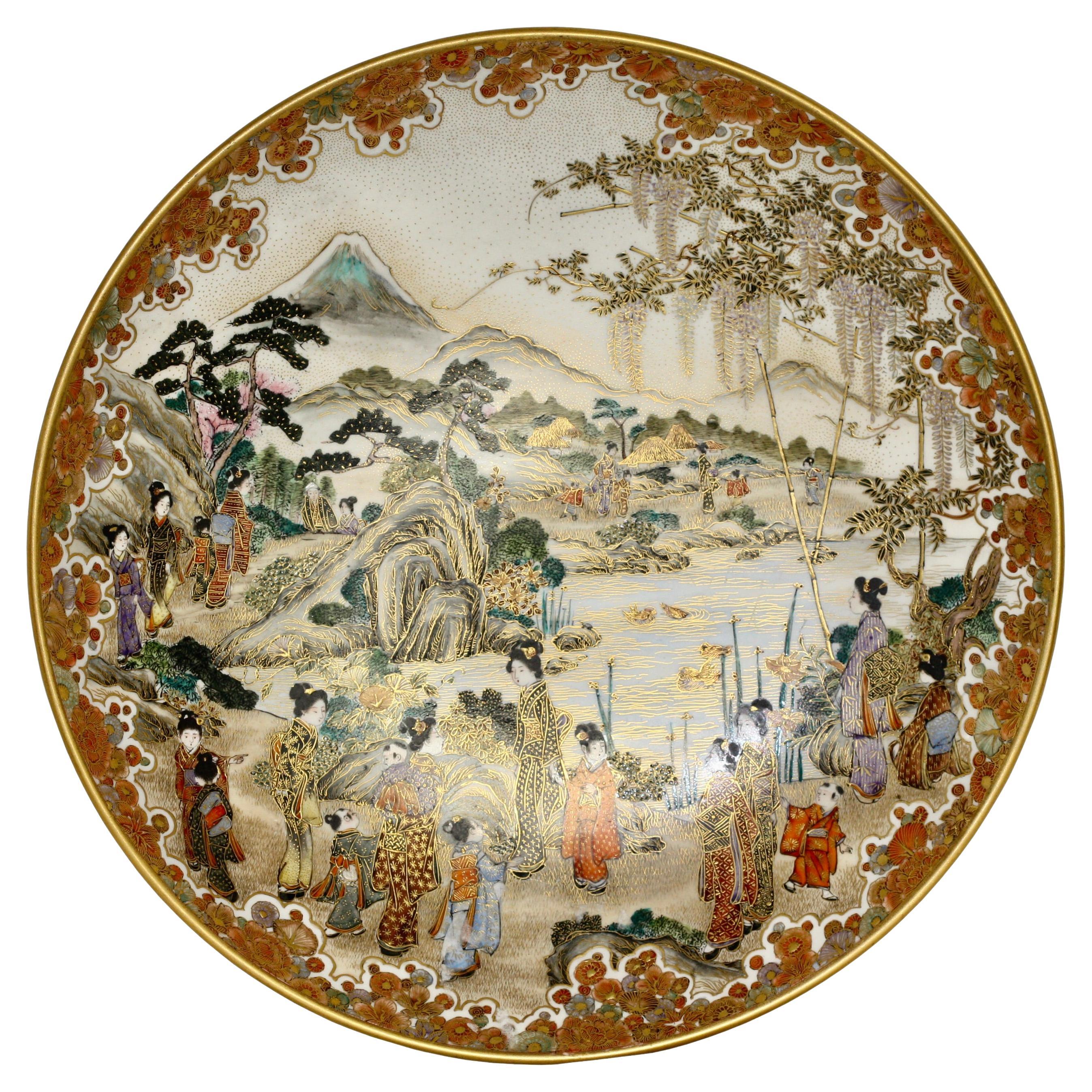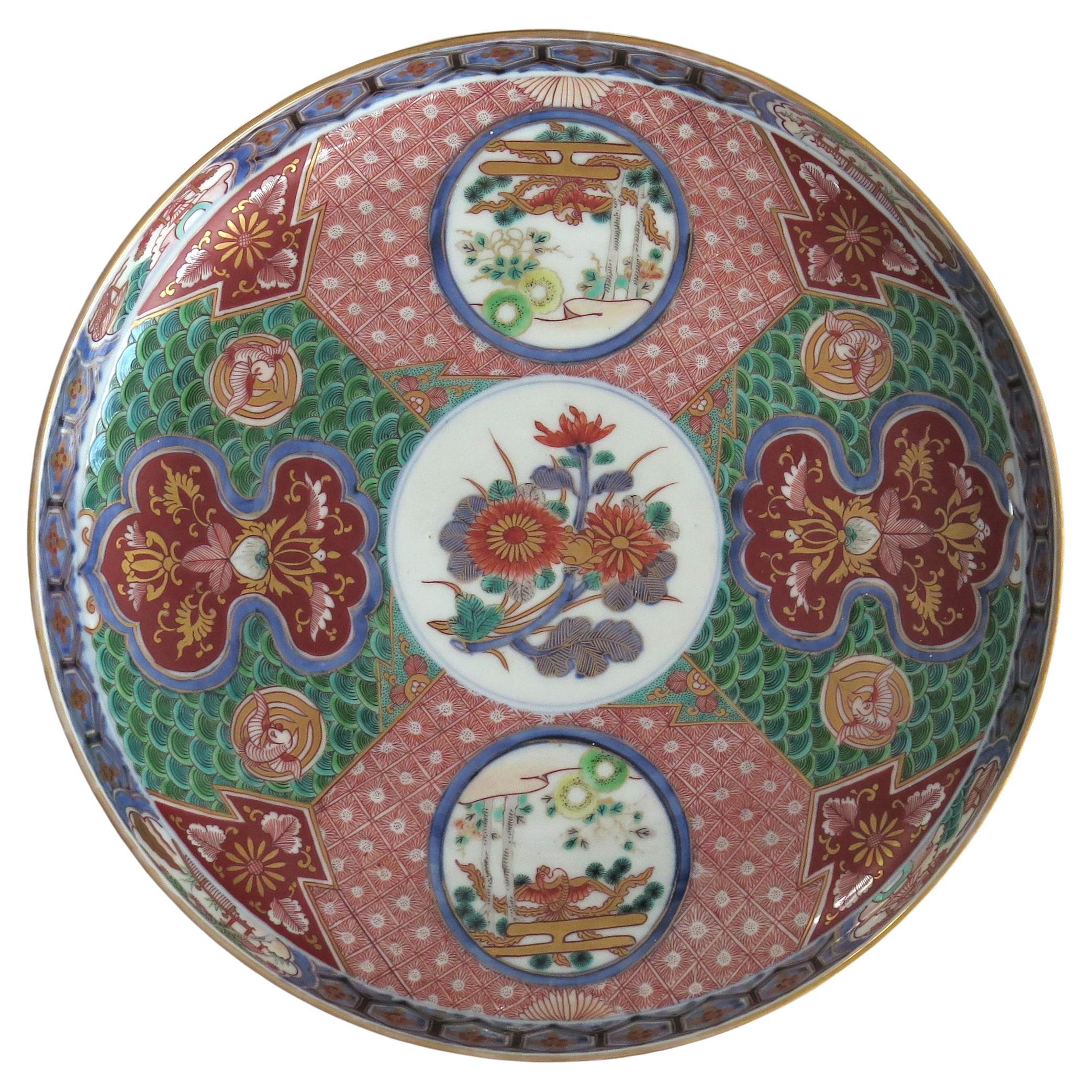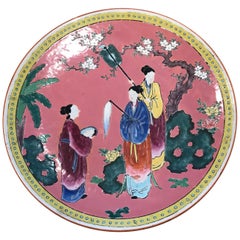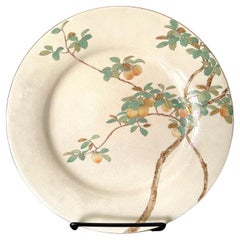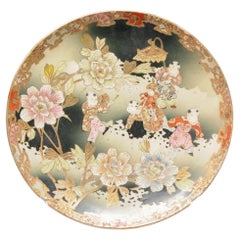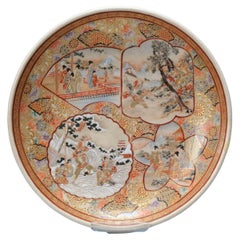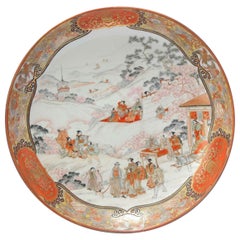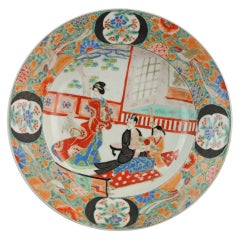Items Similar to Japanese Satsuma Ceramic Dish with Fine Decoration by Kinkozan
Want more images or videos?
Request additional images or videos from the seller
1 of 17
Japanese Satsuma Ceramic Dish with Fine Decoration by Kinkozan
$6,000
£4,587.32
€5,283.67
CA$8,407.84
A$9,386.56
CHF 4,918.42
MX$114,900.74
NOK 62,463.95
SEK 58,895.58
DKK 39,432.54
About the Item
A satsuma ceramic dish made by Kinkozan studio circa 1980-1900s in the late Meiji Period. The dish with a thick robust wall is supported by a large ring base and features finely detailed surface decoration, clearly done by a master hand. Surrounded by clusters of chrysanthemums blossoms in a wide range of varieties, the center of the dish showcases two overlapping panels outlined by gilt borders. One panel depicts a couple with the man sitting on the floor while the lady walking away. The figures were elaborately detailed with attires and coiffures and set on a moriage wave pattern background. The other panel depicts a wooded landscape dotted with flowering plants and flying birds, in which two groups of women and children are pictured playing at their leisure. The composition is natural, with movements and an emphasis on depth in dimension. The rim of the dish is encircled with a band of circles and blossom motifs. The base is signed with hand-scripted four-character "Kinkozan Tsukuru" in a black square with gilt scrolling tendril design. The glaze displays an overall even fine crackle. The workmanship is superb and can be catalogized as "miniature art" characterized by the painstaking details. The chrysanthemum clusters were done in a subtly raised moriage with precision in forms and painterly application of colors. The lively rendition of all the characters is meticulous to the tiniest detail such as the raised texture of the woman's white head scarf and woven pattern in their kimonos.
The Kinkozan family established their pottery business first in 1645 and by the end of 19th century, it had become the largest studio producer of Satsuma ware. By the 1850s, Kinkozan Sobei (Kinkozan IV; 1824-84) started to export the wares to the west, particularly to America, together with the Kyoto manufacturer Taizan VIII. This continued and expanded under the leadership of Kinkozan V (1868-1927) until his death in 1927 when the studio closed. Although due to the large output from the studio and target of the markets, the quality varied considerably, Kinkozan did produce some of the best satsuma pieces from Meiji period. This dish is a good example.
- Creator:Kinkozan (Maker)
- Dimensions:Height: 1.75 in (4.45 cm)Diameter: 8.75 in (22.23 cm)
- Style:Meiji (Of the Period)
- Materials and Techniques:Ceramic,Glazed
- Place of Origin:
- Period:
- Date of Manufacture:1890-1900s
- Condition:Wear consistent with age and use. Fine condition with scattered rubbing off the gilt along the rim in keeping with the age.
- Seller Location:Atlanta, GA
- Reference Number:1stDibs: LU945032796252
About the Seller
4.9
Platinum Seller
Premium sellers with a 4.7+ rating and 24-hour response times
Established in 2006
1stDibs seller since 2010
565 sales on 1stDibs
Typical response time: <1 hour
- ShippingRetrieving quote...Shipping from: Atlanta, GA
- Return Policy
Authenticity Guarantee
In the unlikely event there’s an issue with an item’s authenticity, contact us within 1 year for a full refund. DetailsMoney-Back Guarantee
If your item is not as described, is damaged in transit, or does not arrive, contact us within 7 days for a full refund. Details24-Hour Cancellation
You have a 24-hour grace period in which to reconsider your purchase, with no questions asked.Vetted Professional Sellers
Our world-class sellers must adhere to strict standards for service and quality, maintaining the integrity of our listings.Price-Match Guarantee
If you find that a seller listed the same item for a lower price elsewhere, we’ll match it.Trusted Global Delivery
Our best-in-class carrier network provides specialized shipping options worldwide, including custom delivery.More From This Seller
View AllFine Japanese Ceramic Plate by Kinkozan for Yamanaka & Co.
By Kinkozan
Located in Atlanta, GA
A fine Japanese ceramic satsuma plate made by Kinkozan and retailed by Yamanaka & Co. circa 1900-20s (late Meiji to early Tasho Period). The cream-color...
Category
Early 20th Century Japanese Meiji Ceramics
Materials
Ceramic
Japanese Porcelain Plate
Located in Atlanta, GA
An Japanese porcelain plate circa 1930s-1940s. Decorated with over glaze featuring three ladies in waiting. In the garden, the rock grottoes, a cherry tree in blossom, a half hidden banana tree and a few peeking peonies, suggest a subtropical scenery. The ladies were pictured as holding various item, a fly...
Category
Early 20th Century Japanese Japonisme Ceramics
Materials
Ceramic
$1,000
Antique Japanese Ceramic Ko-Kutani Revival Footed Dish
Located in Atlanta, GA
A Japanese glazed ceramic footed dish made in the Ko-Kutani type of Edo period but likely during Kutani revival in the 19th century Meiji Period. The dish with delicate foliaged rim ...
Category
Antique 19th Century Japanese Japonisme Ceramics
Materials
Ceramic
Fine Japanese Ceramic Plate by Kinkozan for Yamanaka & Co.
By Kinkozan
Located in Atlanta, GA
A fine Japanese ceramic satsuma plate made by Kinkozan and retailed by Yamanaka & Co. circa 1900-20s (late Meiji to early Tasho Period). The cream-color glazed plate features a very fine decoration of a persimmon tree bearing fruits. The composition is poetic, stylized but also realistic, with a literati painter's quality, and was advantageously enhanced by the enamel colorings in incredible details. The mastership of the medium came through the piece. It is signed on the base in gilt kanji seal (Made by Kinkozan) and branded Yamanaka & Co in English. The plate was likely commissioned by the company from Kinkozan for its various galleries in US and Europe.
The Kinkozan family established their pottery business first in 1645 and by the end of 19th century, it had become the largest studio producer of Satsuma ware. By the 1850s, Kinkozan Sobei...
Category
Early 20th Century Japanese Meiji Ceramics
Materials
Ceramic
Fine Japanese Ceramic Plate by Kinkozan for Yamanaka & Co.
By Kinkozan
Located in Atlanta, GA
A fine Japanese ceramic satsuma plate made by Kinkozan and retailed by Yamanaka & Co. circa 1900-20s (late Meiji to early Tasho Period). The cream-color glazed plate features a very fine decoration of a persimmon tree bearing fruits. The composition is poetic, stylized but also realistic, with a literati painter's quality, and was advantageously enhanced by the enamel colorings in incredible details. The mastership of the medium came through the piece. It is signed on the base in gilt kanji seal (Made by Kinkozan) and branded Yamanaka & Co in English. The plate was likely commissioned by the company from Kinkozan for its various galleries in US and Europe.
The Kinkozan family established their pottery business first in 1645 and by the end of 19th century, it had become the largest studio producer of Satsuma ware. By the 1850s, Kinkozan Sobei...
Category
Early 20th Century Japanese Meiji Ceramics
Materials
Ceramic
Japanese Ceramic Dish Meiji Ogata Kenzan
Located in Atlanta, GA
A Japanese ceramic shallow dish in square form with rounded corners from Meiji period in the style of Ogata Kenzan. The dish features a cream color crackl...
Category
Antique 19th Century Japanese Meiji Ceramics
Materials
Ceramic
You May Also Like
Antique 19th C Meiji Japanese Satsuma Plate, Charger Very Large Unmarked
Located in Amsterdam, Noord Holland
A very large Japanese Satsuma Plate of playing boys, Meiji Period. Incredible and very detailed piece. Just superb
Condition
Perfect, just some usage...
Category
Antique 19th Century Japanese Meiji Ceramics
Materials
Porcelain
$1,699 Sale Price
20% Off
Antique Meiji Period Japanese Satsuma Plate Figures with Mark Japan 19th Century
Located in Amsterdam, Noord Holland
Fabulous Japanese earthenware Satsuma dish depicting Figures. Satsuma Ceramic with mark. Japan – Meiji period (1868-1912)
Mark at the base: Made by Hotoda
Additional information:
M...
Category
Antique 19th Century Japanese Meiji Decorative Dishes and Vide-Poche
Materials
Porcelain
$950 Sale Price
20% Off
Antique Japanese Edo/Meiji Kutani Charger with Figural Landscape Scene, 19th Cen
Located in Amsterdam, Noord Holland
Very lovely piece with a nicely painted landscape scene of figures, birds and boats in a flowering landscape.
marked at the base.
Additional information:
Material: Porcelain & Pott...
Category
Antique 19th Century Japanese Decorative Dishes and Vide-Poche
Materials
Porcelain
$1,350 Sale Price
20% Off
Japanese Porcelain Plate Arita Japan Zoshuntei marked Base Geisha, 19th Century
Located in Amsterdam, Noord Holland
Cool plate
Additional information:
Material: Porcelain & Pottery
Type: Plates
Region of Origin: Japan
Period: 19th century
Japan Dynasty Period: Meiji Period (1867-1912)
Japanese St...
Category
Antique 19th Century Japanese Meiji Dinner Plates
Materials
Porcelain
$258 Sale Price
20% Off
An Earthenware Dish By Kinkozan, Meiji period, late 19th century
By Kinkozan
Located in West Palm Beach, FL
An earthenware dish
By Kinkozan, Meiji period, late 19th century
Painted in polychrome enamels and gilt over a clear crackled glaze with beauties and children enjoying a summer outing in a mountainous water landscape, the scene surrounded by a frame of blossoming flower heads,
signed in gilt Kinkozan zo...
Category
Antique 19th Century Antiquities
Materials
Ceramic
Japanese Large porcelain Dish Imari-Arita Hand Painted signed Edo Period Ca 1810
By Arita
Located in Lincoln, Lincolnshire
This is a very beautiful example of a Japanese, Arita- Imari porcelain large Dish or Platter with finely hand painted decoration, dating to the Edo period circa 1810.
This dish is v...
Category
Antique Early 19th Century Japanese Edo Ceramics
Materials
Ceramic
More Ways To Browse
Japanese Crackle
Ring Dish
Ceramic Japan Wall Art
Ceramic Wall Head
Antique Japanese Rings
Japanese Ceramic Birds
Satsuma Pottery
Japanese Satsuma Pottery
Scroll Japanese Birds
Antique Japanese Miniature
Antique Japanese Wall Panels
Antique American Glaze Pottery
Flying Birds Wall
Studio Pottery Bird
Antique Ring Dish
Studio Pottery Dish
Flying Lady
Antique Childrens Rings
